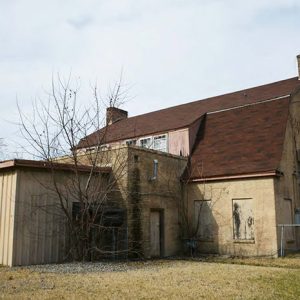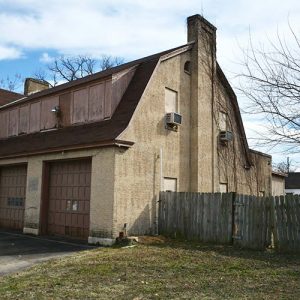calsfoundation@cals.org
Little Rock Fire Station No. 9
Little Rock Fire Station No. 9 is a two-story frame building with a brick veneer located at 2023 East Sixth Street in the Garlands Addition of Little Rock (Pulaski County). The fire station was designed by Little Rock architect H. Ray Burks and constructed in 1930 by the C. L. Hardin Construction Company of Little Rock. It was listed on the National Register on September 14, 2020.
The Little Rock Fire Station No. 9 is characterized as a blend of Tudor Revival and Colonial Revival architectural elements, with a painted brick exterior, large brick chimneys, and both a steeply pitched gable roof and a gambrel roof with shed dormers, covered in asphalt shingles. The fire station is rectangular, with a brick extension on the south side and a metal-clad addition to the south of that. The building sits on a poured concrete foundation and is oriented toward the four cardinal directions, which was determined by the preexisting street grid.
Little Rock Fire Station No. 9 was one of three fire stations constructed in 1930 as a result of a bond issue that aimed to increase the availability of emergency services to edges of the city at that time. Though the area where the station was built was predominantly industrial for most of its existence, there had been a dramatic increase in the number of residences during the interwar years. Many of these houses were occupied by the predominately African-American workers of the surrounding industrial operations. The closest fire station to the area prior to the construction of Little Rock Fire Station No. 9 was located roughly 1.25 miles away. Rail lines that divided the residential area from the rest of the city also made it difficult for emergency response personnel to act quickly.
The Little Rock Fire Station No. 9 was completed in late May 1930 at a cost of $14,229, after only sixty-four days of construction. Engine Company No. 9 moved into its station on June 16 with a 1929 American LaFrance 750-gallon pumper, which had been purchased with the bond funds. In January 1937, the station received a second truck: a new 1937 American LaFrance 500-gallon pumper.
Due to the increased capacity of the station, a second crew was assigned on July 14, 1930, to the station, Engine Company No. 11. The arrival of Engine Company No. 11 was accompanied by the arrival of a 1912 American LaFrance aerial ladder truck, which had been previously housed at Central Fire Station. Engine 11 remained at Little Rock Fire Station No. 9 until October 1, 1945. That same year, an addition was constructed on the southern side of the station in order to accommodate the increased length of the aerial ladder truck, which had previously been stored outside of the station. In 1953, a new municipal bond issue was passed to again upgrade the fire department with stations and apparatus. Part of this funding was used to construct an expansion on the 1945 addition on Fire Station No. 9.
During the long life of Fire Station No. 9, it served as a center of the local community. The station was also used as a polling station for the area for much of its life. However, on July 12, 1963, Engine Company No. 9 was relocated to Little Rock Fire Station No. 12, on the eastern side of the airport, to help with staffing the crash trucks. The relocation of the engine company led to the closure of the station in that same year.
In 1964, the building was purchased by Low-key Supply and Jobbing, which used the building as its central office for the area. This was followed by the purchase of the building by Opportunities Industrial Center in 1972, which stayed at that address until it was purchased by James Terry in 1984. That same year, Terry opened an auto body repair shop in the lower level of the building. He also remodeled the upper floor to accommodate gatherings of the Imperial Social Club of Little Rock, a local African-American civic group. In order to allow more direct access to the meeting space on the upper level, Terry constructed an exterior set of stairs, near the chimney on the eastern side of the building, that tied into the landing of the interior staircase. As part of this, a window was converted into a door to allow access to the interior staircase. Terry continued to operate his business out of the building until 2009, when he retired.
By 2020, the building was used partially for storage and part of it was rented out to a small welding business. Plans have been reported, however, to restore the station to its former glory and convert it into a Little Rock firefighters museum and fire education center.
For additional information:
“City to Ask Bids on Nine Fire Trucks.” Arkansas Gazette, March 7, 1930.
“Contracts for Fire Stations Are Awarded.” Arkansas Democrat, March 5, 1930.
Harrison, Eric E. “Nonprofit Seeks to Save Fire Station.” Arkansas Democrat-Gazette, November 28, 2021, pp. 1D, 10D. Online at https://www.arkansasonline.com/news/2021/nov/28/nonprofit-seeks-to-save-fire-station/ (accessed November 29, 2021).
“History of the LRFD.” City of Little Rock. Online at www.littlerock.gov/city-administration/city-departments/fire-department/history-of-the-lrfd/ (accessed December 31, 2020).
“Little Rock Fire Station No. 9.” National Register of Historic Places registration form. On file at Arkansas Historic Preservation Program, Little Rock, Arkansas. Online at http://www.arkansaspreservation.com/National-Register-Listings/PDF/PU8795.nr.pdf (accessed December 31, 2020).
“The New, the Old for Firemen.” Arkansas Gazette, January 31, 1937.
Witsell, Charles, and Gordon Wittenberg. Architects of Little Rock: 1833–1950. Fayetteville: University of Arkansas Press, 2014.
Bob Franklin
Alexander, Arkansas
J. Mason Toms
Arkansas Historic Preservation Program
 Early Twentieth Century, 1901 through 1940
Early Twentieth Century, 1901 through 1940 Historic Preservation
Historic Preservation Fire Station No. 9 Rear View
Fire Station No. 9 Rear View  Fire Station No. 9 Side Entrance
Fire Station No. 9 Side Entrance  Little Rock Fire Station No. 9
Little Rock Fire Station No. 9  Little Rock Fire Station No. 9, Front View
Little Rock Fire Station No. 9, Front View 




Comments
No comments on this entry yet.